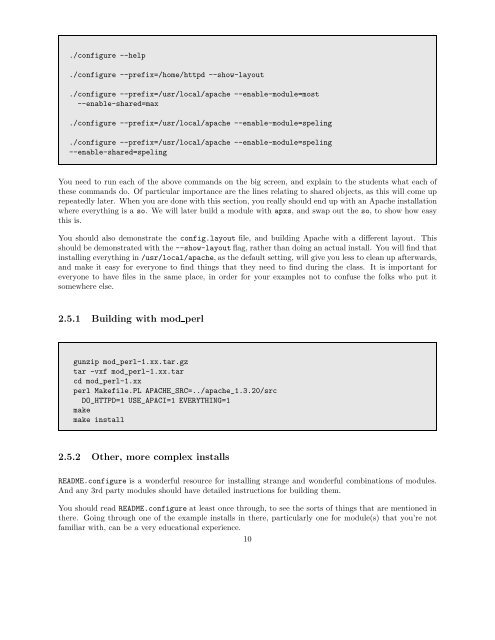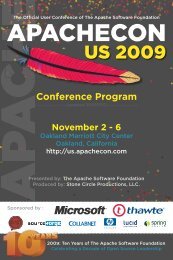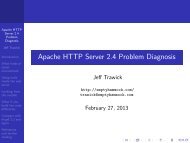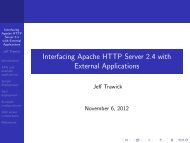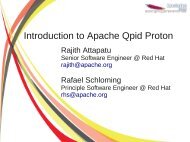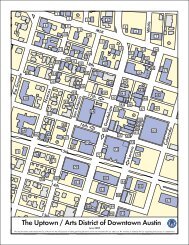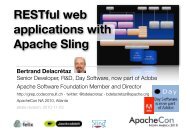Introduction to the Apache Web Server - ApacheCon
Introduction to the Apache Web Server - ApacheCon
Introduction to the Apache Web Server - ApacheCon
You also want an ePaper? Increase the reach of your titles
YUMPU automatically turns print PDFs into web optimized ePapers that Google loves.
./configure --help<br />
./configure --prefix=/home/httpd --show-layout<br />
./configure --prefix=/usr/local/apache --enable-module=most<br />
--enable-shared=max<br />
./configure --prefix=/usr/local/apache --enable-module=speling<br />
./configure --prefix=/usr/local/apache --enable-module=speling<br />
--enable-shared=speling<br />
You need <strong>to</strong> run each of <strong>the</strong> above commands on <strong>the</strong> big screen, and explain <strong>to</strong> <strong>the</strong> students what each of<br />
<strong>the</strong>se commands do. Of particular importance are <strong>the</strong> lines relating <strong>to</strong> shared objects, as this will come up<br />
repeatedly later. When you are done with this section, you really should end up with an <strong>Apache</strong> installation<br />
where everything is a so. We will later build a module with apxs, and swap out <strong>the</strong> so, <strong>to</strong> show how easy<br />
this is.<br />
You should also demonstrate <strong>the</strong> config.layout file, and building <strong>Apache</strong> with a different layout. This<br />
should be demonstrated with <strong>the</strong> --show-layout flag, ra<strong>the</strong>r than doing an actual install. You will find that<br />
installing everything in /usr/local/apache, as <strong>the</strong> default setting, will give you less <strong>to</strong> clean up afterwards,<br />
and make it easy for everyone <strong>to</strong> find things that <strong>the</strong>y need <strong>to</strong> find during <strong>the</strong> class. It is important for<br />
everyone <strong>to</strong> have files in <strong>the</strong> same place, in order for your examples not <strong>to</strong> confuse <strong>the</strong> folks who put it<br />
somewhere else.<br />
2.5.1 Building with mod perl<br />
gunzip mod_perl-1.xx.tar.gz<br />
tar -vxf mod_perl-1.xx.tar<br />
cd mod_perl-1.xx<br />
perl Makefile.PL APACHE_SRC=../apache_1.3.20/src<br />
DO_HTTPD=1 USE_APACI=1 EVERYTHING=1<br />
make<br />
make install<br />
2.5.2 O<strong>the</strong>r, more complex installs<br />
README.configure is a wonderful resource for installing strange and wonderful combinations of modules.<br />
And any 3rd party modules should have detailed instructions for building <strong>the</strong>m.<br />
You should read README.configure at least once through, <strong>to</strong> see <strong>the</strong> sorts of things that are mentioned in<br />
<strong>the</strong>re. Going through one of <strong>the</strong> example installs in <strong>the</strong>re, particularly one for module(s) that you’re not<br />
familiar with, can be a very educational experience.<br />
10


